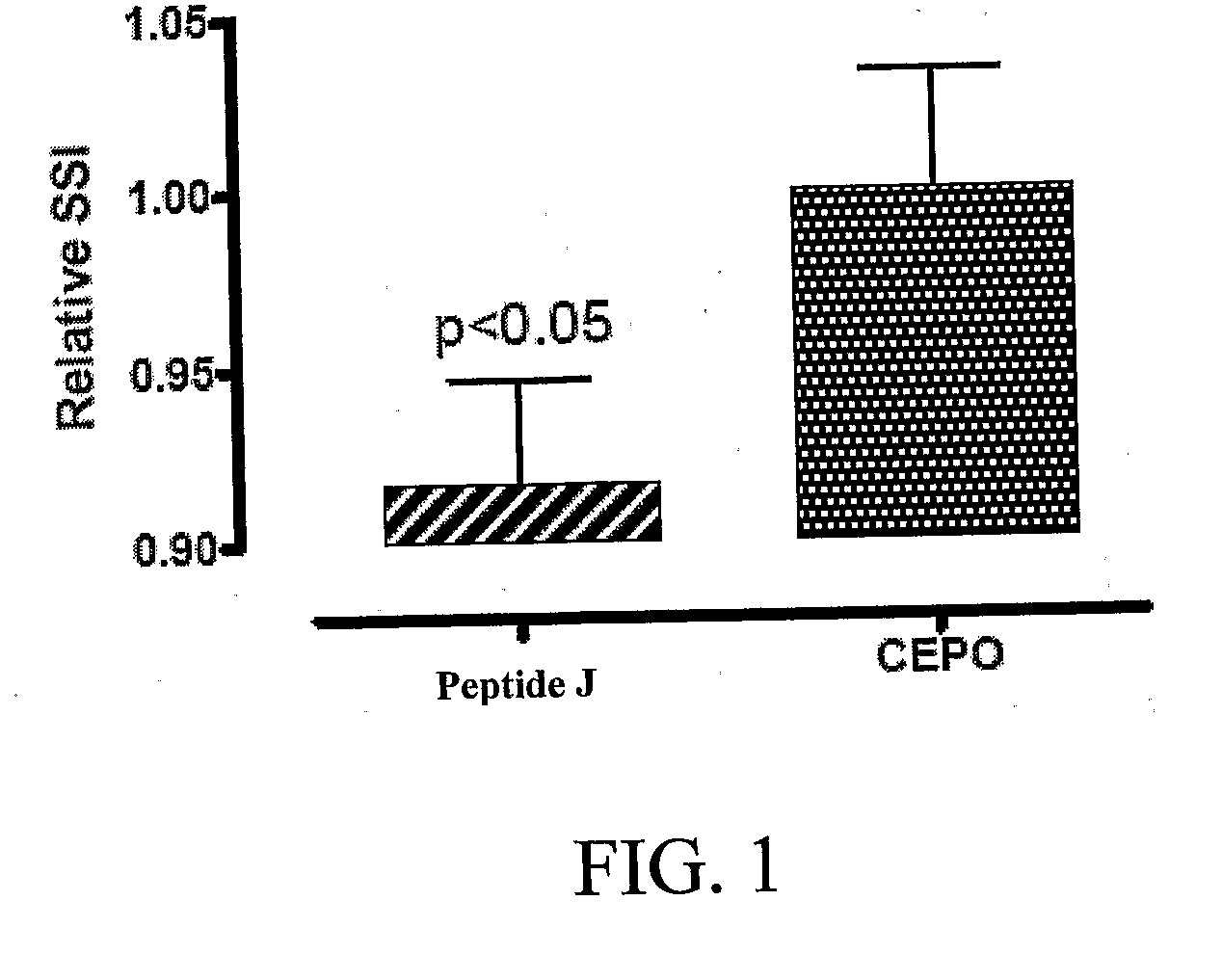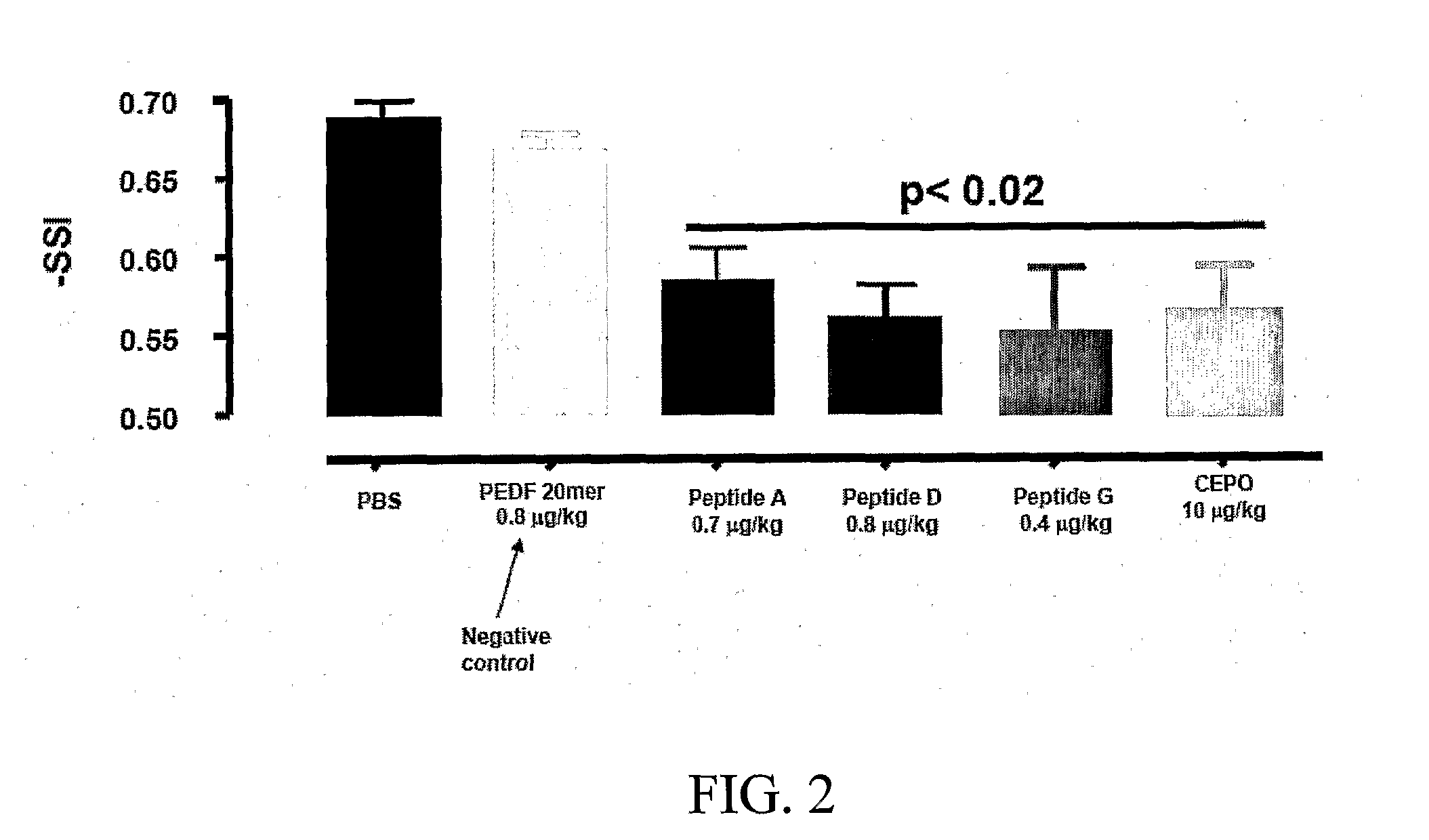Tissue protective peptides and uses thereof
a technology of tissue protective peptides and peptides, which is applied in the direction of peptide/protein ingredients, dna/rna fragmentation, fusion polypeptides, etc., can solve the problems of decreased epo production and often anemia, and achieve the effect of “delay” damag
- Summary
- Abstract
- Description
- Claims
- Application Information
AI Technical Summary
Benefits of technology
Problems solved by technology
Method used
Image
Examples
example 1
Method of Peptide Synthesis
[0217]A. Synthesis of Peptide A (SEQ ID NO:32, corresponding to EPO amino acid sequence 38-57) and Peptide B (SEQ ID NO:34, corresponding to EPO amino acid sequence 58-82).
[0218]Peptide A, SEQ ID NO:32, and Peptide B, SEQ ID NO:34, fragments of EPO (see Table 1), were synthesized using “in situ neutralization” Boc Chemistry stepwise solid-phase peptide synthesis, as described in Band, D., Chopra, N. and Kent, S., “Total Synthesis of Crambin,” J. AM. CHEM. SOC. 2004, 126, 1377-1383 (incorporated by reference herein in its entirety). Briefly, two fragments corresponding to EPO amino acid sequence 38-57 (peptide C, NITVPDTKVNFYAWKRMEVG, SEQ ID NO:29) and EPO amino acid sequence 58-82 (peptide D, QQAVEVWQGLALLSEAVLRGQALLV, SEQ ID NO:30) were synthesized on —OCH2-Pam-resins (free αcarboxyl peptides) or on HSCH2CH2CO-Leu-OCH2-Pam-Resin (“thioester peptides). During synthesis the side chains of various amino acids were protected as follows: Arg(Tos), Asn(Xan), As...
example 2
Validation of Peptide-Mediated Tissue Protection
[0219]The tissue protective peptides were tested for any tissue protective activity using a Sciatic Nerve Assay. Sprague-Dawley rats (250-300 grams) (six per group, including control) were anesthetized using isoflurane (Baxter NPC 10019-773-60) and a Table Top Laboratory Anesthesia System (flowmeter set to 2-3 liters / minute @ 55 psi) for at least 3 minutes. The rat was then placed on a homeothermic blanket to ensure that the core temperature of the rat was maintained at 35-37° C. during the operation. Core temperature was monitored via a rectal probe. The right sciatic nerve of the anesthetized rat was exposed at mid thigh through a quadriceps muscle dissection; a 2 cm incision with a 15 blade scalpel was made through the skin parallel and over the quadriceps muscle and the quadriceps muscle was cut to expose the sciatic nerve using a pair of dissecting scissors. The sciatic nerve was then freed from the surrounding membranes. A 2-0 br...
example 3
Tissue Protective Peptides are Non Erythropoietic
A. In Vitro Assessment:
[0225]UT-7epo, a human erythropoietin-dependent leukemia cell line, was used for the determination of the erythropoietic potency of the peptides. UT-7epo cells (Deutsche Sammlung von Mikroorganismen und Zellkulturen (DSMZ), Cat. No. ACC 363) were grown in a complete RPMI-1640 medium with 10% FBS and 5 ng / ml erythropoietin. The proliferation / survival (=viability increase) response of the cells exposed to erythropoietin is mediated by the classical erythrocyte-type erythropoietin receptor and is a quantitative measure of the capacity of erythropoietin-variants to stimulate the classical erythropoietin receptor.
[0226]UT-7epo cells were transferred to fresh complete RPMI 1640 medium containing 10% donor calf serum, 4 mM L-glutamine, and supplemented with 5 ng / ml of recombinant human erythropoietin. The cells were maintained in 75 cm2 flasks with 20 ml of medium / flask in a humidified incubator with 5% CO2 at 37° C. f...
PUM
| Property | Measurement | Unit |
|---|---|---|
| Fraction | aaaaa | aaaaa |
| Time | aaaaa | aaaaa |
| Weight | aaaaa | aaaaa |
Abstract
Description
Claims
Application Information
 Login to View More
Login to View More - R&D
- Intellectual Property
- Life Sciences
- Materials
- Tech Scout
- Unparalleled Data Quality
- Higher Quality Content
- 60% Fewer Hallucinations
Browse by: Latest US Patents, China's latest patents, Technical Efficacy Thesaurus, Application Domain, Technology Topic, Popular Technical Reports.
© 2025 PatSnap. All rights reserved.Legal|Privacy policy|Modern Slavery Act Transparency Statement|Sitemap|About US| Contact US: help@patsnap.com



